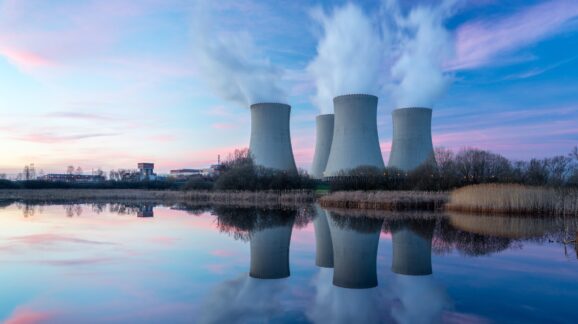Senators asking the right question on nuclear license renewals

Photo Credit: Getty
Sen. Shelley Moore Capito (R-WV) ranking member of the Senate
Environment and Public Works Committee and Sen. Pete Ricketts (R-NE) ranking member of the Committee’s Subcommittee on Clean Air, Climate, and Nuclear Safety sent an important letter on November 1 to Nuclear Regulatory Commission (NRC) Chairman Christopher T. Hanson. They requested that the Commission take action to improve its review and approval process for subsequent license renewals that extend the operating licenses of nuclear plants. Their letter is a necessary show of congressional interest in ensuring NRC efficiency.
What are subsequent license renewals?
In the US, nuclear reactors are initially licensed for a period of 40 years. Plant operators can apply to the NRC for two extensions, each covering a 20-year period. The first extension, a license renewal, takes the reactor from its 40th to 60th year. The second extension, a subsequent license renewal, runs from the 60th year to the 80th. License renewals and subsequent license renewals allow the maximum benefit to be derived from a nuclear reactor.
One of nuclear power’s key advantages is the long operating lives of reactors. License renewals and subsequent license renewals are essential to ensuring that this benefit is realized. The vast majority of reactors in the US have already received a license renewal. According to Power Magazine Executive Editor Aaron Larson, as of June, “87 of the 92 commercially operating nuclear reactors in the U.S. have had their licenses extended to 60 years.” License renewals are entirely common among the US reactor fleet.
In the coming years, these operators will need their second extension. Therefore, subsequent license renewals will only grow more common. This is especially true since the vast majority of nuclear reactors are expected to last for 80 years. As mentioned in the senators’ letter, “the nuclear industry now expects that more than 90 percent of today’s operating reactors plan to extend operation from 60 years to 80 years.” With more of these subsequent license renewals expected, the efficiency of this process is paramount.
What is wrong with how the NRC is currently handling subsequent license renewals?
Last winter, after receiving legal pressure from anti-nuclear groups, the NRC began a rule-making to create a new environmental review process for subsequent license renewals. The rule-making was already originally planned to take two years. It has been delayed beyond this already long timeline.
In addition to this rulemaking, the NRC also reduced the subsequent license renewals that had already been granted to two reactors in Florida, Turkey Point Units 3 and 4, and two reactors in Pennsylvania, Peach Bottom Units 2 and 3. While these reactors have their subsequent license renewals, the NRC severely curtailed the duration of the licenses. Now they will only last until the end dates of their initial license renewals (early 2030s) instead of the end dates initially permitted by their subsequent license renewals (early 2050s). Further, these recent NRC actions will affect nine other nuclear reactors whose operators have applied for subsequent license renewals.
Nuclear operators seeking subsequent license renewals are now required to either wait for the rule-making to be completed, or provide the NRC with a site-specific environmental review. Neither of these options is proving effective. Site-specific reviews are long and costly, and lose all of the benefits of a formalized process.
Senators are asking the right questions. In their letter, Sens. Capito and Ricketts state, “The Commission’s misguided 2022 reversal of previously issued SLRs [subsequent license renewals] resulted in a cascading delay that impedes the ability for nuclear utilities to make long-term planning decisions and support those decisions with necessary investments.”
Plant operators require the stability of long-term planning. They need the ability to trust that approvals they have received will be upheld and will not be changed arbitrarily. Capito and Ricketts are absolutely right in their assertion that these reversals are misguided, and that this rule-making overall has been an impediment to the planning abilities of the country’s nuclear power plants, especially those with impending renewals.
Continuity is essential in nuclear power plant operations. A reactor is not simply turned off and back on again. Once a plant is shut down it begins the decommissioning process. This is expensive and difficult to reverse at the early stages, and entirely impractical later on in the process. Because of this, ensuring permitting continuity is essential.
The senators also outline some important questions for NRC Chairman Hanson. Among these is a question that really gets to the heart of the matter. They asked, “What specific steps is the Commission, as a whole, taking to ensure the NRC’s subsequent license renewal review and approval process is efficient, timely, predictable, and affordable?”
This question highlights the importance of things like predictability and timeliness in the licensing process, while also putting emphasis on the failure of NRC to deliver on these necessities by asking for specificity in describing the virtues of the process. Given how the process has gone, this will be a tough question to answer.
Nuclear plants in the US are by and large capable of lasting 80 years. Many plant closures that occur prematurely are motivated by pressure from anti-nuclear groups, or even from individuals who tout net zero goals while simultaneously pushing to close reliable nuclear capacity.
This new NRC rulemaking has been unnecessarily lengthy and disruptive. Further, retroactively reducing the length of already granted licenses is a recipe for confusion and distrust. Capito and Ricketts are right to question the NRC about these harmful actions.
A version of this article first ran in Catalyst.